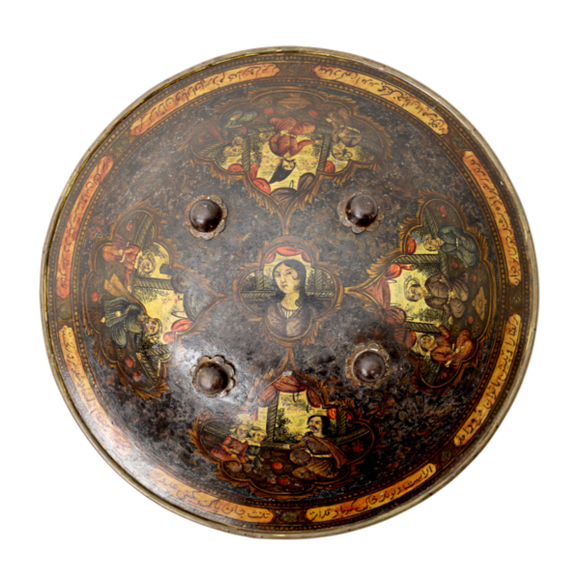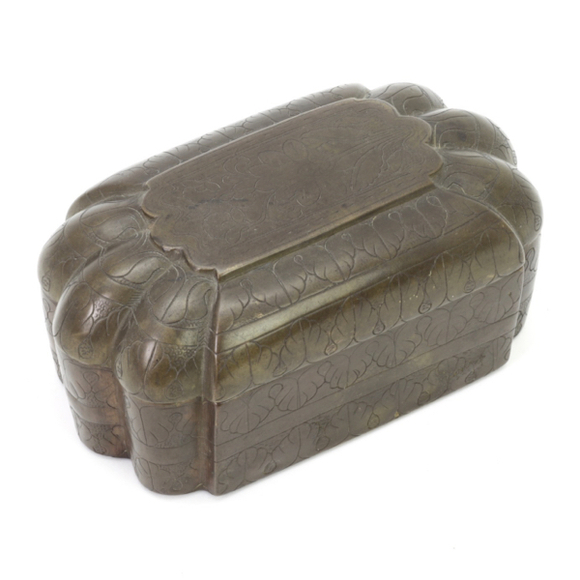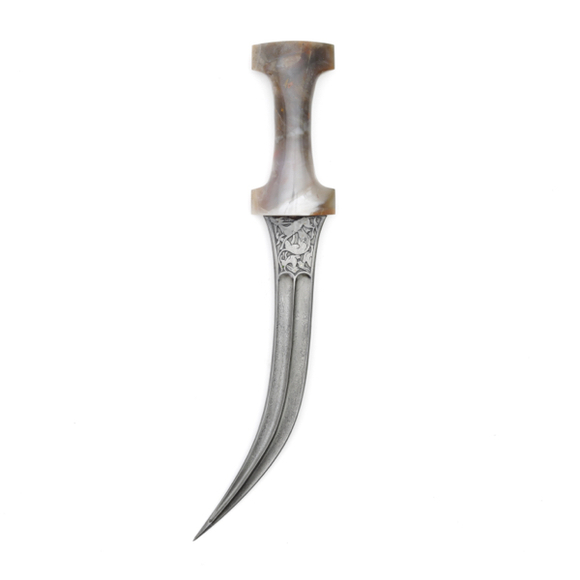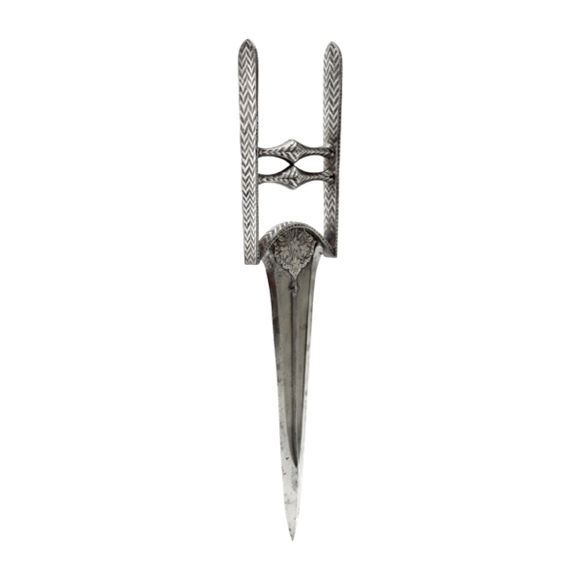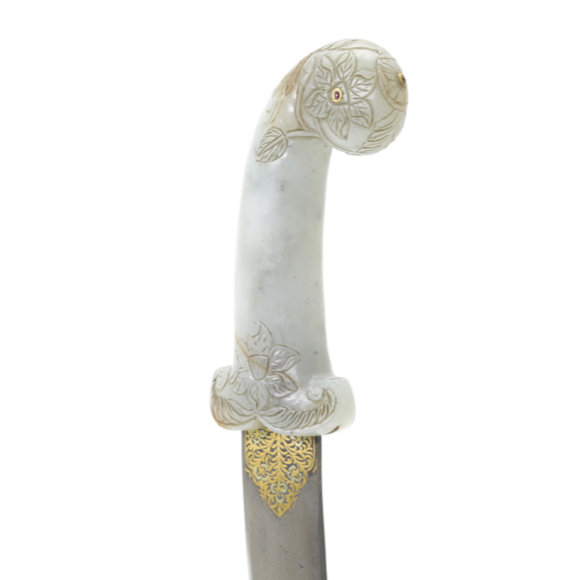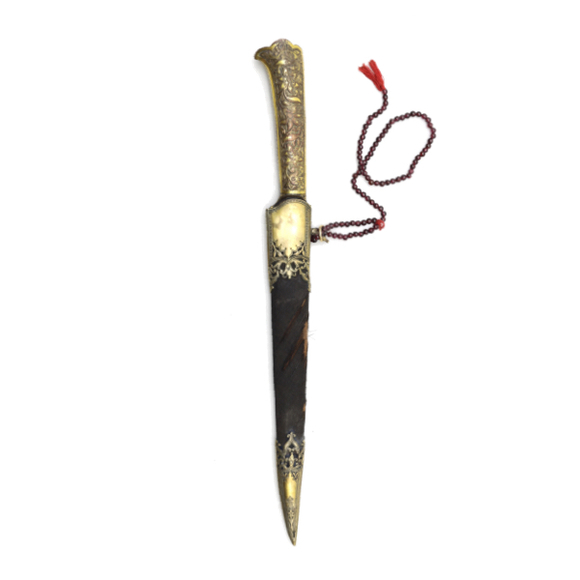Language: Persian
Source: Period writings and dictionaries
Description
Koft-garī (کوفت گری) is the Persian word for the inlay and overlay of gold or silver on iron or steel.1 As a Persian loan word it was widely used from the Ottoman Empire to north India.
It was also called simply koft (کوفت). It consists of the words: koft (کوفت); Interwoven; a blow, bruise, and garī (گری); practice, trade. The person who does the work is called the koftgar (کوفت گر).2
In Hindi, it is written koftgari (कोफ़्तगरी).3
The original meaning meant to describe any kind of inlay or overlay but among collectors today, koftgarī is almost exclusively used for a type of overlay over a crosshatched background. The true inlay is known as tah-nishān (ته نشان) where tah means "to fold" and nishān "to mark".
Notes
1. Francis Joseph Steingass; A comprehensive Persian-English dictionary, including the Arabic words and phrases to be met with in Persian literature. London: Routledge & K. Paul, 1892.
2. Thomas Holbein Hendley, C.I.E.; Damascening On Steel or Iron, as practised in India. W. Griggs & Sons, Ltd. London 1892.
3. R. S. McGregor; The Oxford Hindi-English dictionary. Oxford University Press, 1993. Page 217.
Types of work
Two main types of koftgarī can be distinguished:
1. "True inlay" or tah-i-nishan
The gold or silver is beaten into channels. It can be polished flush with the surface or made to stand out a little, in which case it was called zar-i-nishan. Both methods are very durable but also very labor-intensive. On antique arms of India, true inlay is rare and highly prized by collectors.2
2. "Overlay" where the gold or silver is applied on a crosshatched surface. When new and well done it may look similar to zar-i-nishan but it is far less durable. When the gold wears down it will reveal the cross-hatching underneath. This is the most commonly found method for antique arms today.
Centers of production
Although similar work done on bronze can be traced to ancient Egypt, the work as we know it today is generally believed to have originated in Persia and was spread to India through the Timurids, into the Punjab and later also in Rajputana.1
By the late 19th century, known centers of production in India were Kashmir, Gujarat, Sialkot in the Punjab, Multan, Lucknow, Jaipur, Karauli, Alwar, Datiá and Hyderabad.2 In the early 20th century, only Sialkot koftgars were still known to be in operation.3
In Persia, the craft mainly survived in Isfahan and Shiraz up until the late 19th century and possibly into the 20th.
I have no doubt that the art survived in more areas but was just not documented. Today, good work is still, or again, being done in Pakistan, Afghanistan, Syria and north India.
Notes
1. Thomas Holbein Hendley, C.I.E.; Damascening On Steel or Iron, as practised in India. W. Griggs & Sons, Ltd. London 1892.
2. Official catalogue of the Empire of India exhibition: Earl's Court, London, S.W. Printed and published by J.J. Keliher & Co., London. 1895. Pages 214-215.
3. Monograph on Iron and Steel Industries in the Punjab 1906-07. Lahore, 1908. Page 6-7.
In period sources
Trailokya Nath Mukharji, 1888:
"As its name implies, the industry originated at Damascus, where it underwent its highest development in the hands of the early goldsmiths. It was, however, brought to India directly from Kabul and Persia. Kotli Lohiran near Sialkot and Gujarat, both in the Panjib, are the two chief seats of this industry, but the art is also practiced at Lahore, Jaipur, Karauli, Alwar, Datiá &c. It is also practised to a small extent in Multan, where it was introduced about two hundred years ago by one Muhammad Murid.
The use for which it was originally invented was the decoration of arms and armour, and the glory of the art has departed with that of the mighty warriors of old who fought with shields and swords, buckles and breastplates, and maces and matchlocks. The art has therefore got antiquated, but happily the makers have turned it to the ornamentation of articles for ordinary use, chiefly in a European household, and in the manufacture of such things as well as of shields, arms, and armoury which Europeans purchase as curios, Koftgari work in India still maintains its precarious existence."
Continue reading at archive.org
-Trailokya Nath Mukharji; Art manufactures of India, specially compiled for the Glasgow International Exhibition, 1888
Superintendent of Government printing, Calcutta, India, 1888.
Pages 177-180.
Sir George Watts, 1903:
"The art of damascening appears to have taken its origin with the ornamentation of swords and other weapons. On the decline of the Sikh power, the koftgari workers of Sialkot and Gujerat diverted their skill to the ornamentation of articles for domestic use. To this day, however, they still prepare damascened sword and dagger handles, scabbards, shields, helmets, etc. The best examples of this work to be seen in the Exhibition are sword handles ( Nos. 4143 and 4145 ), by Shabab Din, son of Imam Din, prices Rs. 50 and Rs. 100.
In Jaipur, Alwar, Datia, Jodhpur and in Serhoi, the art of damascening sword handles attained high proficiency. A shield has been arranged to display the damascening of Jaipur, which is mostly silver or gold on steel in elaborate and intricate patterns. In Datia and Jodhpur the work is very similar, as, for example, sword handle (No. 10), price Rs. 31. In Serhoi (Plate No. 11-A, figs. 10 and 11), a background of frosted silver is given round the gold, producing thereby a characteristic style which, although not confined to Serhoi, is more or less peculiar to that State.
The same system is occasionally practised in Sialkot, as for example the gauntlets (No. 4161), Rs. 50. A shield has been designed to exhibit a full display of Serhoi arms as also a further shield to display a special series of Jaipur arms, mostly those that manifest engraved and damascened steel. One of the chief centres of damascened arms in India is doubtless Hyderabad in the Deccan (Plate No. II-A, fig. 15). A large shield has been arranged to show a selection of the silver and a second the gold damascening of that State.

The above brief reference may suffice to denote the older manifestations of the art of damascening. Mr. Brown's sketch (Plate No. 11) of the damascene worker in Datia, shows the artist with his appliances engaged damascening a sword hilt. His reels of gold and silver thread are in front of him, and an enlarged hilt on the wall shows the pattern turned out.
Panjab. — Of modern work it may be said that Gujerat and Sialkot in the Panjab, and more recently Jaipur, Alwar, Serhoi and Lahore, turn out large quantities. The materials employed are steel plates engraved in minute arabesque designs, into which silver and gold wire are hammered. But there are various forms or qualities of this work, the most valuable being that known as:
(A) Teh Nashen or deep Koftgari (Plate No. 11-A, figs, 1, 2 and 3). — In this the steel is deeply engraved and thick gold or silver wire hammered into the grooves. It is then filed down, cleaned and blued, until it forms a perfectly smooth and polished surface. At times when both gold and silver are used (Ganga-Jamná) certain parts of the gold are mixed with copper in order to obtain a pinkish tint. The surface is blued through the action of fire only. A good example of this style is the small boat-shaped tray from Jaipur (No. 2141), Rs. 100, and the circular tray from Sialkot, Rs 50.
(B) Ordinary or shallow Koftgari (Plate No 11-A, figs. 6 and 7). — In this case the design is engraved in shallow grooves or scratchings, and a very fine wire is hammered into these. The amount of silver and gold employed is accordingly very small, and in consequence the surface cannot be polished and smoothened as in the teh nashen without removing the gold and silver wire. Accordingly, with the cheaper forms of koftgari, the wire can be readily felt on the surface.
(C) Lastly, the cheapest form of all is a sort of imitation koftgari. This is called Dewálí (Plate No. 11-A, fig. 12). The surface is smoothened with a file and afterwards with pumice stone. The pattern is then scratched with the style and lime juice sprinkled over it to thoroughly cleanse the surface. It is next heated and gold leaf (lifted with a pair of pincers) is applied and lightly hammered, then rubbed with the mori stone, which causes the gold to adhere to the portions of the surface scratched for its reception. The best example of dewálí work in the Exhibition is the plate (No. 3906), Rs. 75, made by Sultan Mahamad of Sialkot.

Rajputana. — The degree of hammering applied to koftgari causes the gold or silver to spread out in all three forms of work. In Rajputana it would appear that a fourth system prevails, namely, dewálí work subsequently scratched to remove portions of the gold and produce a closer similarity to wire inlaying.
Sialkot and Gujerat.— {Plate No. II-A, figs. 4-9 and 12) — The most desirable examples are: — from Gujerat a tray by Fazal Ahmad, Rs. 131; a tháli (tray) by Abdul Aziz, Rs. 150; another by Maula Bux, Rs. 93; a suráhi by Mahomed Azum, Rs. 25 ; a golábdani by the same maker, Rs. 81; and a suráhi by Abdul Aziz, Rs. 37.
From Sialkot a suráhi, silver and gold on iron, by Koftgar Nazar Mahamad, son of Kutubdin, Rs. 50; a suráhi, silver and gold on iron, by Nurdin, Rs. 15; a lota, silver and gold on steel, by Budha, Rs. 62; a shield, gold and silver on steel, by Golab Din, Rs. 125; a tháli, gold on steel, by Budha, Rs. 62; a cháraina (set of armour) by Musa, son of Khush Mahamad, Rs. 150; a thali, silver and gold on steel, by Haji Mahamad Yar, son of Sultan Mahamad, Rs. 125.
From Lahore a shield in gold damascening by Aim Din, Rs. 156; a cháraina (set of armour) by the same maker, Rs. 1,871. From Jaipur, a tray, gold on steel, by the School of Art, Rs. 100; a dhál (shield) by Khuda Buksh, Rs. 125 a koft suráhi (goblet) also by Khuda Buksh, Rs. 25; a suráhi, gold on steel, by the School of Art, Jaipur, Rs. 56. It may be added, of the two last named specimens, that they are perhaps the most highly finished and best examples of koftgari m the Exhibition.
Travancore may be said to have a style of koftgari of its own, which consists of roughened steel with gold wire beaten into it in the form of floral designs of a strongly Dravidian type; this may be seen in the tray, gold on iron, by the School of Art, Trevandrum, Rs. 62 (Plate No. II-A, fig. 14), and the casket (fig. 13).
-Sir George Watt; Indian art at Delhi, 1903. Being the official catalogue of the Delhi exhibition, 1902-1903.
Indian Art Exhibition, Delhi, 1903.
Pages 43-46.

